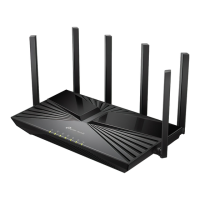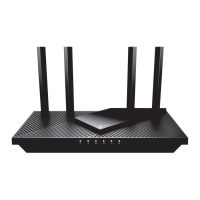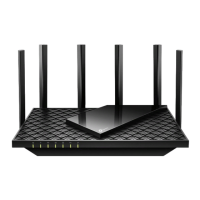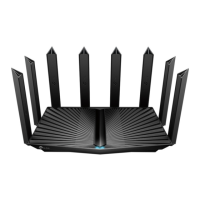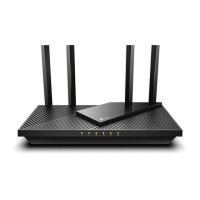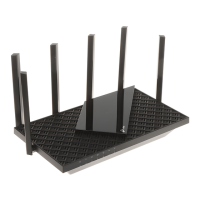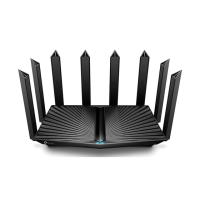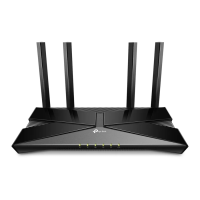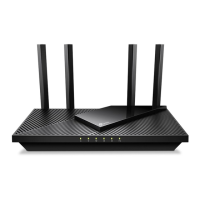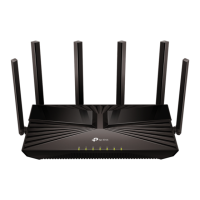Do you have a question about the TP-Link Archer AXE95 and is the answer not in the manual?
Explains conventions used in the guide for text formatting and symbols.
Provides links to download center, support, and community pages for further assistance.
Details the router's Wi-Fi 6E technology, performance features like OFDMA and 1024QAM.
Describes the physical appearance and explains the LED status indicators on the router.
Offers advice on where to place the router for optimal performance and safety.
Provides step-by-step instructions for connecting the router to the modem and power source.
Details the process to access and log into the router's web-based management utility.
Guides users through the automated wizard for initial internet connection setup.
Explains how to configure the router using the TP-Link Tether mobile application.
Provides steps for manually setting up the internet connection based on ISP details.
Describes how to configure the router to extend an existing wired network wirelessly.
Outlines the process for setting up an internet connection using the IPv6 protocol.
Instructions for creating a TP-Link ID to manage the router and access cloud features.
Guide on how to change the email address and password for your TP-Link ID.
Details on adding and removing other TP-Link IDs for router management.
Explains how to use the TP-Link Tether app for remote router management.
Covers changing SSID, password, security, and advanced wireless parameters.
Allows users to set a schedule for the wireless network to turn on or off automatically.
Describes how to connect devices to the router using the WPS button or PIN method.
Explains settings like WMM, AP Isolation, Airtime Fairness, and signal parameters.
Steps to create a separate Wi-Fi network for guests with custom SSID and security.
Customizes guest access rules, like allowing communication between guests or with the local network.
Instructions on how to insert and access files on USB devices connected to the router.
Allows streaming media files from USB storage to DLNA-compatible devices.
Guides on setting up the router for Mac Time Machine backups to a USB drive.
Overview of features for protecting the network from malicious attacks and intrusions.
Manages internet access, time limits, and content filtering for family members.
Utilizes HomeShield for network performance analysis and optimization.
Explains how to use the SPI firewall to defend against online threats.
Manages network access for specific devices by creating allowed or blocked lists.
Secures the network by binding device IP addresses to their MAC addresses to prevent spoofing.
Configures port forwarding to make local network services accessible on the internet.
Sets up port triggering to dynamically open external ports for specific applications.
Exposes a device to the internet with all ports open for unrestricted communication.
Enables UPnP to automatically manage ports for online gaming and real-time applications.
Guides on setting up OpenVPN for secure remote access to the home network.
Instructions for setting up PPTP VPN for easier remote network access.
Explains conventions used in the guide for text formatting and symbols.
Provides links to download center, support, and community pages for further assistance.
Details the router's Wi-Fi 6E technology, performance features like OFDMA and 1024QAM.
Describes the physical appearance and explains the LED status indicators on the router.
Offers advice on where to place the router for optimal performance and safety.
Provides step-by-step instructions for connecting the router to the modem and power source.
Details the process to access and log into the router's web-based management utility.
Guides users through the automated wizard for initial internet connection setup.
Explains how to configure the router using the TP-Link Tether mobile application.
Provides steps for manually setting up the internet connection based on ISP details.
Describes how to configure the router to extend an existing wired network wirelessly.
Outlines the process for setting up an internet connection using the IPv6 protocol.
Instructions for creating a TP-Link ID to manage the router and access cloud features.
Guide on how to change the email address and password for your TP-Link ID.
Details on adding and removing other TP-Link IDs for router management.
Explains how to use the TP-Link Tether app for remote router management.
Covers changing SSID, password, security, and advanced wireless parameters.
Allows users to set a schedule for the wireless network to turn on or off automatically.
Describes how to connect devices to the router using the WPS button or PIN method.
Explains settings like WMM, AP Isolation, Airtime Fairness, and signal parameters.
Steps to create a separate Wi-Fi network for guests with custom SSID and security.
Customizes guest access rules, like allowing communication between guests or with the local network.
Instructions on how to insert and access files on USB devices connected to the router.
Allows streaming media files from USB storage to DLNA-compatible devices.
Guides on setting up the router for Mac Time Machine backups to a USB drive.
Overview of features for protecting the network from malicious attacks and intrusions.
Manages internet access, time limits, and content filtering for family members.
Utilizes HomeShield for network performance analysis and optimization.
Explains how to use the SPI firewall to defend against online threats.
Manages network access for specific devices by creating allowed or blocked lists.
Secures the network by binding device IP addresses to their MAC addresses to prevent spoofing.
Configures port forwarding to make local network services accessible on the internet.
Sets up port triggering to dynamically open external ports for specific applications.
Exposes a device to the internet with all ports open for unrestricted communication.
Enables UPnP to automatically manage ports for online gaming and real-time applications.
Guides on setting up OpenVPN for secure remote access to the home network.
Instructions for setting up PPTP VPN for easier remote network access.
| Brand | TP-Link |
|---|---|
| Model | Archer AXE95 |
| Category | Wireless Router |
| Language | English |

